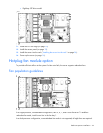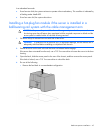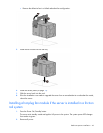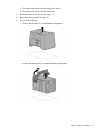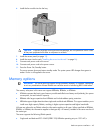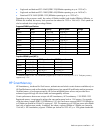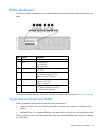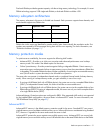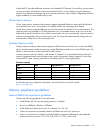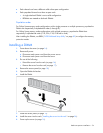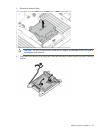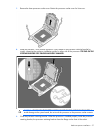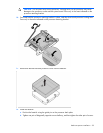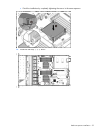
Hardware options installation 52
Advanced ECC provides additional protection over Standard ECC because it is possible to correct certain
memory errors that would otherwise be uncorrected and result in a server failure. Using HP Advanced
Memory Error Detection technology, the server provides notification when a DIMM is degrading and has a
higher probability of uncorrectable memory error.
Online Spare memory
Online Spare memory mode provides protection against degraded DIMMs by reducing the likelihood of
uncorrected memory errors. This protection is available without any operating system support.
Online Spare memory protection dedicates one rank of each memory channel for use as spare memory. The
remaining ranks are available for OS and application use. If correctable memory errors occur at a rate
higher than a specific threshold on any of the non-spare ranks, the server automatically copies the memory
contents of the degraded rank to the online spare rank. The server then deactivates the failing rank and
automatically switches over to the online spare rank.
Lockstep Memory mode
Lockstep memory mode provides protection against multibit memory errors that occur on the same DRAM
device. Lockstep memory mode can correct any single DRAM device failure on x4 and x8 DIMM types. The
DIMMs in each channel must have identical HP part numbers.
Lockstep memory mode uses channel 1 and channel 2. Channel 3 is not populated. Because channel 3
cannot be populated when using Lockstep memory mode, the maximum memory capacity is lower than
Advanced ECC mode. Memory performance with Advanced ECC is also slightly higher.
Maximum capacity
Type Rank Single processor Dual processors
RDIMM
Single 48 GB 96 GB
RDIMM
Dual 96 GB 192 GB
LRDIMM
Quad 192 GB 384 GB
UDIMM
Single 12 GB 24 GB
UDIMM
Dual 48 GB 96 GB
For the latest memory configuration information, see the QuickSpecs on the HP website
(http://www.hp.com).
Memory population guidelines
General DIMM slot population guidelines
Observe the following guidelines for all AMP modes:
• Install DIMMs only if the corresponding processor is installed.
• Do not mix LRDIMMs, UDIMMs, or RDIMMs.
• White DIMM slots denote the first slot of a channel (1-A, 2-B, 3-C).
• When two processors are installed, balance the DIMMs across the two processors.
• When two processors are installed, install the DIMMs in sequential alphabetical order balanced
between the two processors: P1-A, P2-A, P1-B, P2-B, P1-C, P2-C, and so forth.



